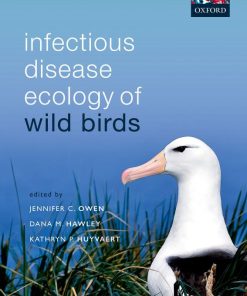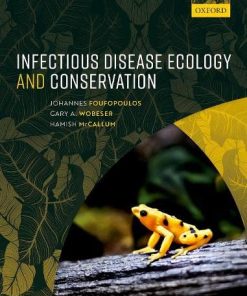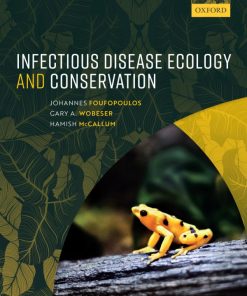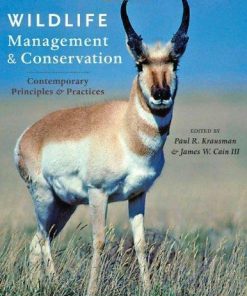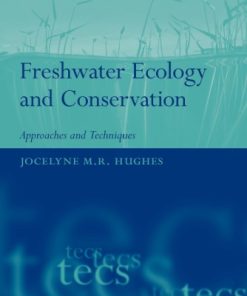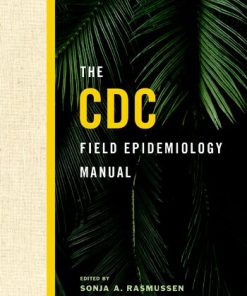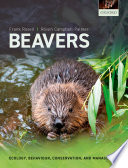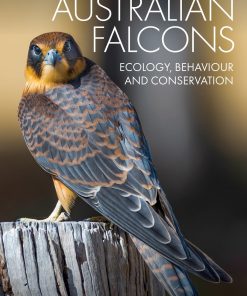Emerging Zoonotic and Wildlife Pathogens Disease Ecology Epidemiology and Conservation 1st edition by Dan Salkeld, Skylar Hopkins, David Hayman 0192560407 9780192560407
$50.00 Original price was: $50.00.$25.00Current price is: $25.00.
Emerging Zoonotic and Wildlife Pathogens: Disease Ecology, Epidemiology, and Conservation 1st edition by Dan Salkeld, Skylar Hopkins, David Hayman – Ebook PDF Instant Download/DeliveryISBN: 0192560407, 9780192560407
Full download Emerging Zoonotic and Wildlife Pathogens: Disease Ecology, Epidemiology, and Conservation 1st edition after payment.
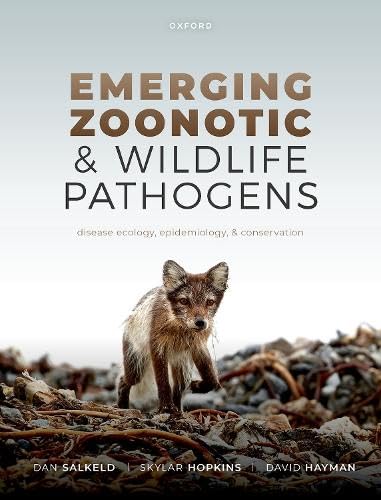
Product details:
ISBN-10 : 0192560407
ISBN-13 : 9780192560407
Author : Dan Salkeld, Skylar Hopkins, David Hayman
This accessible book describes a fascinating range of emerging infectious disease outbreaks affecting humans, including rabies, Ebola virus, Lyme disease, bubonic plague, and of course, Covid-19. The book also covers emerging infectious diseases in wildlife, such as Tasmanian devil facial tumour disease, white nose syndrome, mange, and musk ox lungworm. These case studies span the entire range of zoonotic disease emergence pathways, from sheep testicles in Wyoming, USA to butchered bush rats in Vietnam! Transmission dynamics are examined from diverse perspectives – from global drivers of pathogen emergence (including globalization, land use patterns, and changing climates) to outbreak epidemiology (epidemic curves and disease spillover), to conservation and control interventions. Despite a recent explosion of courses on the topic, and a viral pandemic that has affected the entire world, this is the first textbook to focus on pathogen spillover ecology at the human—wildlife interface. Emerging Zoonotic and Wildlife Pathogens serves as an introduction to this multidisciplinary field for upper-level undergraduate students and graduate students interested in disease ecology, veterinary epidemiology, public health, and conservation. It will also be relevant to a broader interdisciplinary audience of conservation biologists and public health specialists, and even the interested public.
Emerging Zoonotic and Wildlife Pathogens: Disease Ecology, Epidemiology, and Conservation 1st Table of contents:
1 Spillover and emerging infectious diseases
1.1 Introduction
1.2 From spillover to pandemic
1.3 Zoonoses
1.4 Zoonotic origins of the `Big Three’
1.5 Barriers to emergence
1.6 Ebola virus as a case study of spillover
1.7 Improved diagnostics and increasing rate of pathogen discovery
1.8 Epidemiology meets disease ecology
1.9 Why study the ecology and epidemiology of infectious disease?
1.10 Notes on sources
1.11 References
SECTION 1 Describing Outbreaks
2 The anatomy of disease
2.1 Modes of pathogen transmission—direct contact
2.2 Airborne transmission
2.3 Environmental transmission
2.4 Vehicle-borne transmission
2.5 Vector-borne transmission
2.6 Vertical or congenital transmission
2.7 Portals of host entry
2.8 Host exits
2.9 Infectious, latent, incubation, and symptomatic periods
2.10 Disease
2.11 Disease agent groups
2.12 Summary
2.13 Notes on sources
2.14 References
3 Descriptive epidemiology of disease outbreaks
3.1 Primary and index cases
3.2 Epidemic curves
3.3 Interpreting epidemic curve patterns
3.4 Common source outbreaks
3.5 Incubation periods and outbreak exposures
3.6 Propagated transmission
3.7 Test validity
3.8 Test validity, within-host pathogen dynamics, and test type
3.9 Test validity and local pathogen prevalence
3.10 Test validity and repeat tests
3.11 Pooled samples
3.12 Summary
3.13 Notes on sources
3.14 References
4 Surveillance
4.1 Surveillance approaches
4.2 Aggregating data
4.3 Aggregating data: ecologic fallacy and Simpson’s paradox
4.4 Surveillance and zoonotic outbreaks
4.5 Outbreak surveillance
4.6 An outbreak case study
4.7 Summary
4.8 References
5 Making simple predictions using models
5.1 Introduction
5.2 Mathematical models are simplifications of disease systems
5.3 Basic compartmental models
5.4 How does host density affect pathogen transmission?
5.5 Using simple models to make predictions
5.6 The basic reproductive number, R0
5.7 Deterministic vaccination thresholds
5.8 Deterministic invasion thresholds
5.9 When do pathogens drive host species to extinction?
5.10 Predicting long-term dynamics while ignoring random chance
5.11 Incorporating random chance when predicting long-term dynamics
5.12 When models are wrong
5.13 Summary
5.14 References
SECTION 2 Pathogen Sources
6 The environment as a pathogen reservoir
6.1 Introduction
6.2 Five questions to define `environmental reservoirs’
6.3 Soil and plants as environmental reservoirs
6.4 Faeces as an environmental reservoir
6.5 Water as an environmental reservoir
6.6 Summary
6.7 References
7 Reservoir hosts
7.1 Introduction
7.2 Spillover from a single host reservoir: armadillos and leprosy
7.3 Multiple reservoir hosts: rabies, dogs, and wildlife
7.4 Interactions between domestic and wildlife reservoirs
7.5 Spillover from multiple reservoirs: Lyme disease
7.6 Reservoir hosts and the dilution effect
7.7 Multiple reservoir hosts and multiple pathogens: tick-borne diseases
7.8 Idiosyncrasies of human behaviour and exposure to tick-borne pathogens
7.9 Contributions of non-reservoir hosts to local disease ecology
7.10 Summary
7.11 References
8 Identifying animal reservoirs during an epidemic
8.1 Evidence of infection
8.2 Evidence of exposure is not evidence of reservoir competence
8.3 Genomic analyses to identify reservoir sources
8.4 Causal association
8.5 Finding the reservoir for Hantavirus Pulmonary Syndrome
8.6 Outbreaks are not always caused by spillover from reservoirs
8.7 Notes on sources
8.8 References
SECTION 3 Drivers of Infectious Disease Emergence
9 Emerging infectious diseases and globalization—travel, trade, and invasive species
9.1 Travel brings zoonotic infections to non-endemic areas
9.2 Travel drives stuttering outbreaks in non-endemic areas
9.3 Travel drives pandemics
9.4 Wildlife trade drives the spread of infectious diseases
9.5 Invasive species drive disease emergence
9.6 Summary
9.7 Notes on sources
9.8 References
10 Climate change and emerging infectious diseases
10.1 Climate affects host–parasite interactions
10.2 Thermal performance curves
10.3 Climate change and shifting distributions
10.4 Extreme weather events
10.5 Summary: interpreting complex climate–disease patterns
10.6 Notes on sources
10.7 References
11 Land use change and emerging infectious diseases
11.1 Introduction
11.2 What is land use change?
11.3 Deforestation and forest fragmentation
11.4 Wild meat
11.5 Wildlife farming
11.6 Livestock farming
11.7 Agriculture and water use
11.8 Urbanization
11.9 Poverty traps
11.10 Summary
11.11 Notes on sources
11.12 References
SECTION 4 Conservation, Ecology, and Control
12 Impacts of emerging infectious disease on wildlife populations
12.1 Introduction—Arctic foxes and otodectic mange
12.2 Small carnivore populations threatened by pathogens from domestic dog reservoirs
12.3 Small carnivore populations threatened by pathogens from wildlife reservoirs
12.4 Environmental reservoirs and resistant reservoir hosts drive amphibian species to extinction
12.5 Infectious diseases can make common species rare
12.6 Summary
12.7 References
13 Infectious diseases in ecosystems
13.1 Communities and ecosystems
13.2 Bottom-up effects
13.3 Top-down effects: mesopredator release
13.4 Top-down effects: trophic cascades
13.5 Parasites in food webs
13.6 Ecosystem functions performed by parasites
13.7 Co-infection
13.8 Summary
13.9 References
14 Infectious disease control
14.1 Treating infected wildlife: a tale of scabid wombats
14.2 Vector control and vaccination: conserving the plagued black-footed ferret
14.3 Control interventions
14.4 Culling wildlife to prevent wildlife–livestock disease transmission: the case of badgers and
14.5 Culling and wildlife disease reservoirs, more generally
14.6 Unintended consequences—bison, elk, cattle, and brucellosis
14.7 Pathogen invasion and disease control
14.8 A final case study: Guinea worm disease
14.9 Summary
14.10 References
15 COVID-19, One Health, and pandemic prevention
15.1 Rapid emergence of a novel pathogen
15.2 From outbreak to pandemic
15.3 The source of SARS-CoV-2 spillover
15.4 Controlling the spread of a pandemic virus … or not
15.5 Drivers of the COVID-19 pandemic
15.6 Complexity and wicked problems
15.7 The One Health approach and interdisciplinary collaboration
15.8 Preventing pandemics
15.9 Conclusion
15.10 Notes on sources
15.11 References
People also search for Emerging Zoonotic and Wildlife Pathogens: Disease Ecology, Epidemiology, and Conservation 1st:
emerging zoonotic diseases in india
what animals carry zoonotic diseases
emerging zoonotic diseases
emerging zoonoses
emerging zoonosis
Tags: Emerging Zoonotic, Wildlife Pathogens, Disease Ecology, Epidemiology, Conservation, Dan Salkeld, Skylar Hopkins, David Hayman
You may also like…
Medicine - Veterinary Medicine
Medicine
Interdisciplinary Insights from the Plague of Cyprian: Pathology, Epidemiology, Ecology and History
Uncategorized
Mathematics
Freshwater Ecology and Conservation: Approaches and Techniques 1st Edition Jocelyne M.R. Hughes
Medicine - Epidemiology
Animals & Pets - Natural History
Biology and other natural sciences - Zoology




